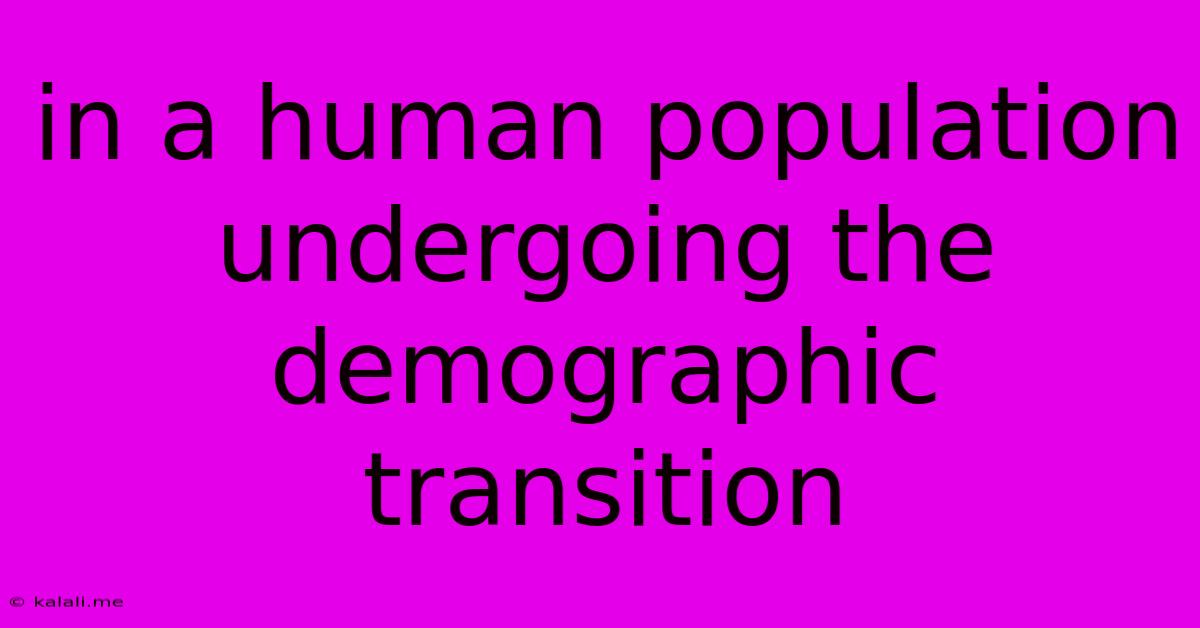In A Human Population Undergoing The Demographic Transition
Kalali
Jun 14, 2025 · 4 min read

Table of Contents
In a Human Population Undergoing the Demographic Transition
Meta Description: Explore the fascinating changes in birth and death rates during a demographic transition, its stages, impacts on population growth, and its global implications. Learn about the factors driving this significant shift in human populations.
The demographic transition is a significant shift in population dynamics characterized by a gradual change in birth and death rates. This transition, observed in many countries throughout history, moves populations from a state of high birth and death rates to one of low birth and death rates. Understanding this process is crucial for comprehending population growth, economic development, and resource management on a global scale.
Stages of the Demographic Transition
The demographic transition model typically outlines four stages, although some models include a fifth:
-
Pre-industrial Stage: This stage is characterized by high birth rates and high death rates. Life expectancy is low due to widespread disease, famine, and limited access to healthcare. Population growth remains relatively stable, with high birth rates offsetting high death rates. Think of pre-industrial societies with high infant mortality and limited access to sanitation.
-
Early Transitional Stage: Death rates begin to decline significantly in this stage, primarily due to improvements in sanitation, healthcare, and food production. Birth rates remain high, resulting in rapid population growth. This period sees a noticeable increase in life expectancy and a decrease in infant mortality. Increased access to medical care and better nutrition are key factors.
-
Late Transitional Stage: Birth rates begin to decline, closing the gap with falling death rates. Population growth continues, but at a slower rate compared to the previous stage. Factors contributing to this decline include increased access to education, particularly for women, leading to greater family planning and career aspirations beyond childbearing. Urbanization also plays a role, as families in urban settings tend to have fewer children.
-
Post-industrial Stage: Both birth and death rates are low, resulting in slow or zero population growth. Life expectancy is high, and the population structure is often characterized by a larger proportion of older individuals. This stage indicates a stable population size, perhaps even a slight decline. Developed nations typically fall into this category.
-
Post-Transitional Stage (Optional): Some models include a fifth stage where population may begin to decline due to factors like low birth rates and an aging population. This stage is often seen in highly developed countries with aging populations and very low fertility rates.
Factors Driving the Demographic Transition
Several factors influence the pace and progression through the stages of the demographic transition:
-
Improved Healthcare: Access to healthcare, including vaccinations, sanitation improvements, and advancements in medical technology, significantly reduces mortality rates.
-
Increased Food Production: Advances in agricultural technology and food distribution lead to better nutrition and reduced food insecurity, lowering death rates.
-
Education and Empowerment of Women: Increased access to education, particularly for women, often correlates with lower fertility rates. Educated women tend to make more informed choices about family planning, delaying childbirth or opting for fewer children.
-
Urbanization: Movement from rural areas to urban centers often leads to changes in family structures and lifestyle choices, contributing to lower birth rates.
-
Economic Development: Higher levels of economic development often lead to lower birth rates, as families focus on investments in education, career advancement, and consumer goods rather than having larger families.
Implications of the Demographic Transition
The demographic transition has profound implications for societies and the global community:
-
Population Growth and Distribution: Understanding the transition helps predict future population size and distribution, which is essential for planning infrastructure, resource allocation, and social services.
-
Economic Development: The shift in population dynamics impacts economic growth, labor markets, and social security systems. An aging population, for instance, can place strain on pension systems.
-
Environmental Impact: Population size and consumption patterns are directly linked to environmental challenges. Understanding population growth trajectories is vital for developing sustainable resource management strategies.
-
Social and Political Implications: Changing age structures and population distributions can impact social structures, political stability, and healthcare systems.
In conclusion, the demographic transition is a complex process with far-reaching consequences. Analyzing this shift in birth and death rates is crucial for effective policymaking and for addressing global challenges related to population growth, economic development, and environmental sustainability. By understanding the factors driving this transition and its implications, we can better prepare for the future.
Latest Posts
Latest Posts
-
Common Multiples Of 48 And 60
Jun 14, 2025
-
Harris Stowe State University Acceptance Rate
Jun 14, 2025
-
Who Designed The National Flag Of India
Jun 14, 2025
-
Lcm Of 6 8 And 15
Jun 14, 2025
-
Which Of The Following Releases Energy
Jun 14, 2025
Related Post
Thank you for visiting our website which covers about In A Human Population Undergoing The Demographic Transition . We hope the information provided has been useful to you. Feel free to contact us if you have any questions or need further assistance. See you next time and don't miss to bookmark.